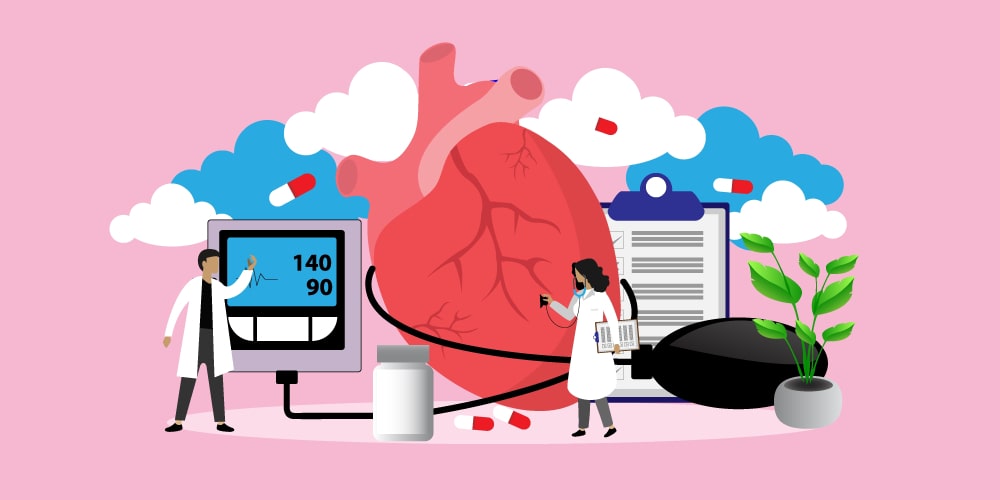Types of Hypertension describe blood pressure which is sustained at a level higher than the generally accepted normal maximum level for a particular age group.
- At 20 years-140/90 mm Hg.
- At 50 years-160/95 mm Hg.
- At 75 years-170/105 mm Hg.
It is classified into the following subtypes:
- Essential, primary, or idiopathic;
- Secondary to other diseases;

Table of Contents
Essential Hypertension
This means hypertension of unknown cause. It accounts for 85-90 percent of all cases and is subdivided according to the rate at which the disease progresses.
Benign (chronic) hypertension
The rise in blood pressure is usually slight to moderate and continues to rise slowly over many years. Sometimes complications are the first indication of hypertension, e.g. heart failure, cerebrovascular accident, myocardial infarction. Occasionally, the rate of progress increases, and the hypertension becomes malignant. Following are the predisposing factors:
- Inherited tendency
- Obesity
- Excessive alcohol intake
- Cigarette smoking
- Lack of exercise
Malignant (accelerated) hypertension
The blood pressure is already elevated and continues to rise rapidly over a few months. Diastolic pressure in excess of 120 mm Hg is common. The effects are serious: hemorrhages into the retina, encephalopathy (cerebral edema), and progressive renal disease leading to cardiac failure.
Secondary hypertension
Hypertension results from other diseases account for 10-15 percent of all cases. It is related to the following factors.
- Kidney disease
- Endocrine disorders
- Structure of the aorta
(a) Kidney disease: Raised blood pressure is a complication of many kidney diseases. The vasoconstrictor effect of excess renin released by damaged kidneys is one of the causative factors.
(b) Endocrine disorders: Secretion of excess aldosterone and cortisol stimulates the retention of excess sodium and water by the kidneys leading to increased blood volume and pressure. Over secretion of aldosterone is due to a hormone-secreting tumor. Over secretion of cortisol may be due to excess stimulation of the gland by ACTH, secreted by the pituitary gland, or to a hormone-secreting tumor.
Secretion of excess adrenaline or noradrenaline leads to an increase in blood pressure. This may be due to a tumor of the adrenal medulla, which is termed as pheochromocytoma.
(c) Structure of the aorta: Hypertension develops in branching arteries proximal to the site of a structure. In compression of the aorta by an adjacent tumor may cause hypertension proximal to the structure.
Hypertension may be a complication of the treatment of certain drugs, e.g. corticosteroids, non-steroidal anti-inflammatory drugs, and oral contraceptives.
Pulmonary hypertension
Raised blood pressure in the pulmonary circulation is secondary to:
- Changes in blood vessels.
- Chronic disease of the respiratory system.
- The disease of the heart.
- Diseases of other organs that cause increased BP in the left side of the heart, e.g. cirrhosis of the liver, thrombosis of the portal vein.
Effects and Complications of Hypertension
The effects of long-standing and progressively rising blood pressure are serious. Hypertension predisposes to atherosclerosis and affects the following specific organs, in particular.
- Heart
- Brain
- Kidneys
Heart: The rate and force of cardiac contraction are increased to maintain the cardiac output against a sustained rise in arterial pressure. The left ventricle increases in size and begins to fail when it reaches the upper limit of its function. This is followed by backpressure and accumulation of blood in the lungs, increase in the size of the right ventricle causing the right ventricular failure. Hypertension also predisposes to other heart diseases.
Brain: Stroke, caused by cerebral hemorrhage is common, the effects depending on the position and size of the ruptured vessel. When a series of small blood vessels are ruptured at different times there is a progressive disability. Rupture of a large vessel causes extensive loss of function or even death.
Kidneys: Essential hypertension causes kidney damage. If sustained for only a short time, recovery may be complete. Otherwise, the kidney damage causes further hypertension, progressive loss of kidney function, and kidney failure.
Make sure you also check our other amazing Article on: Anatomy Of Thyroid Gland
